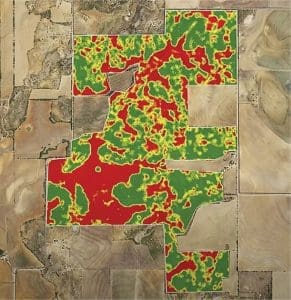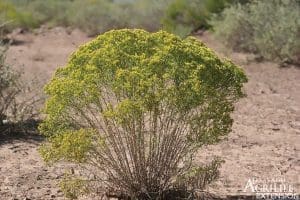By Larry Stalcup, Contributing Editor

One of the driest spells ever was broken this spring and summer by drought-busting rain that blessed the Southern Plains and much of the Southwest. Parched pastures were reborn, regenerating new grass and other grazing fodder for many ranches large and small. But to have forages ready for better grazing next year, producers should consider maintaining a well-rounded fall and winter pasture management program.
University and private company range management specialists encourage producers to use proven brush and weed control techniques to enhance revived grasses and other forages.
“Our pastures soaked up the much-needed rain,” says Jodie Stockett, range and pasture specialist for Corteva Agriscience in Claude, Texas, adding that stalled herd rebuilding and expansion regained life.
However, the welcomed rain also generated weed and brush growth that stole quality forage from rejuvenated pastures across the Southwest and Southern Plains. Texas A&M University AgriLife Extension specialists say weeds and brush can be controlled or prevented by maintaining a thick, vigorous grass stand. That’s easier said than done once weed growth advances or dry weather returns. Mechanical shredding, plowing or chemical methods are often needed.
Several agribusiness service companies provide range management services. Along with Corteva, others include Bayer CropScience and smaller local entities. Independent range and pasture consultants also work with producers to get the most out of their pastures. Regional Extension specialists also provide links to better pasture management.
All would agree that herd rebuilding or expansion starts with enabling grazing land to support more animals over the long term. Getting rid of one pound of weeds enables pastures to produce an additional pound of native grass, AgriLife officials say.
Corteva range and pasture specialists say effective weed and brush control preserves moisture and nutrients for recovering grasses. This increases forage yield, which elevates the energy and protein available to cattle. It helps cows meet their nutritional requirements and that of their calves more efficiently.
While mesquite and weed control highlighted much of the summer’s brush management activity, Stockett says the attention now turns to fall and winter brush control to help grasses obtain their full growth potential for 2024.
Different climates often see different types of brush that can invade pastures. Like other range and pasture managers, regional Corteva specialists center on specific regions. That includes other Southern Plains and regions of the Southwest. They target brush and weeds common to local pastures.
“For example, in the Southern Plains, much rangeland is ripe for broom snakeweed growth,” Stockett says. “Broom snakeweed is toxic to cattle and can cause abortions. It is a perennial shrub that is best treated in the fall with Tordon 22K [picloram]. Treatments should be made at full bloom or slightly post-bloom.”
Other pesky types of brush in the region include locust trees, sagebrush and shinnery oak, which can produce dense thickets. Corteva’s Spike 20P [tebuthiuron] is a pellet-based herbicide that is mainly applied by aerial treatments. It also controls tarbush and creosote bush.
Map out an Advanced Brush Management Plan
Advances in digital technology and imagery help improve many phases of cattle and pasture management. Corteva’s LandVisor system can provide a comprehensive view of an operation’s land. It helps outline various brush and weed management practices and guide range managers with improved pasture management methods.
With LandVisor, ranchers work with certified consultants to collect sample data points across their property to help reveal new insights about the land. Those points are combined with sophisticated imagery to create a vegetation map focusing on specific problem species. Stockett says LandVisor will identify a treatment window for a specific pasture, and prescribe additional herbicide treatments to help improve the land.
Mesquite Guide for Next Spring

“Fall is a good time to get maps established and be ready for next spring,” Stockett says. “LandVisor tells you when to spray and when not to spray.”
It can arm producers with better means for controlling mesquite, a thorny headache for ranchers. AgriLife Extension says high-volume foliar herbicide spraying of mesquite typically begins in spring when leaves change color from light pea-green to a uniform dark green. Spraying usually continues through late summer in South Texas. Spraying in West Texas can start in June and continue into August.
Before spraying, make sure the soil temperature reaches 75° F at 12 to 18 inches deep. Corteva specialists say it’s important to allow any mesquite that has been top killed by hand cutting, fire, mechanical methods or herbicide treatment to grow a minimum of two full growing seasons before using the leaf-spray method.
Corteva’s Sendero (aminopyralid and clopyralid) is a proven herbicide for mesquite control. It can keep treated mesquite plants under control for years if proper guidelines are followed, Stockett says.
Good land sprayer options include small pump-up garden sprayers, backpack sprayers, cattle sprayers or sprayers mounted on all-terrain vehicles. Garden sprayers work well for small acreages. Backpack sprayers are usually more efficient in dense mesquite, and ATV sprayers are most efficient in large acreages or as the distance between plants increases.
Make sure the sprayer has an adjustable-cone nozzle that can deliver a coarse spray of large droplets to the top of a 6- to 8-foot tree. To prepare the spray mix, add Sendero at 1 percent concentration to water. To ensure a thorough coating of the foliage, add a nonionic surfactant to the spray mix.
For additional tree and brush control, consider using basal stem spray applications of Corteva’s Remedy Ultra (triclopyr). It can control relatively young mesquite trees that have smooth bark and few basal stems, or slim trunks emerging from the ground.
“For mesquite and other brush that can hamper grazing efficiency, it’s important to use the proper herbicide, the labeled application rate and the timing of application,” Stockett concludes.
By following these and other range and pasture management tips, the value of rain received in 2023 and the grass it produced this summer can be carried forward for more effective grazing next year.







